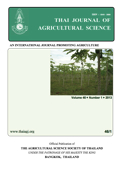Response of Grain Yield and Yield Components of Various Maize Hybrids to Natural Weeds Population
Main Article Content
Abstract
In order to evaluate the weed competition effects on grain yield and yield components of corn, a split plot experiment was carried out based on Randomized Complete Block Design (RCBD) in three replications at Agricultural Research Station of Firoozabad, Fars, Iran in 2015. The main plots included two levels of weed infestations (W0: weed free and W1: weedy) and the sub-plots were consisted of 11 maize hybrids (AS160, AS41, AS42, AS66, AS42, AS51, AS54, AS55, AS62, AS63, AS66, AS72, AS73). The results of ANOVA showed that weeds resulted in reduction of leaf number, flag leaf area, ear length, number of kernels per row and grain yield. AS54 and AS160 hybrids had the highest and lowest grain yield under the weed-free condition, respectively, while, AS62 and AS55 hybrids had the highest and lowest grain yield under the weedy condition, respectively. According to the results of percent of grain yield loss, Ability to withstand competition (AWC) index and cluster analysis, AS62 and AS66 hybrids, which had high grain yield in both weed-free and weedy conditions, were the best genotypes in competition weeds and AS55 hybrid was the worst. Number of rows per ear and number of kernels per row were also the best traits to evaluate genotypes, competitiveness with weeds in weed-free and weedy conditions and to improve grain yield, respectively.


